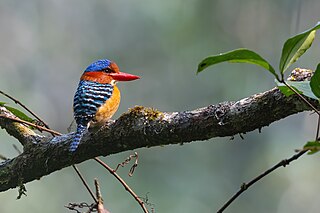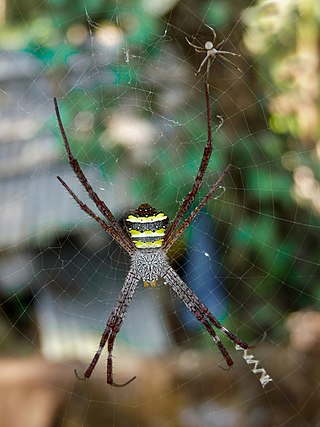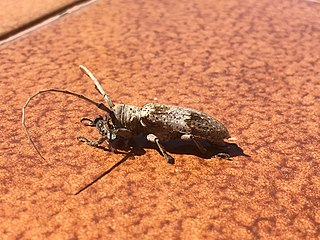
Gaillardia is a genus of flowering plants in the family Asteraceae, native to North and South America. It was named after Maître Gaillard de Charentonneau, an 18th-century French magistrate who was an enthusiastic botanist. The common name may refer to the resemblance of the inflorescence to the brightly patterned blankets made by Native Americans, or to the ability of wild taxa to blanket the ground with colonies. Many cultivars have been bred for ornamental use.

Gaillardia pulchella is a North American species of short-lived perennial or annual flowering plants in the sunflower family.

Acacia pulchella, commonly known as prickly moses or western prickly moses, is a shrub in the family Fabaceae. Endemic to Western Australia, it is one of the most common shrubs of the bushland around Perth and in the Darling Range.

Banksia pulchella, commonly known as teasel banksia, is a species of small shrub that is endemic to the south-west of Western Australia. It has smooth grey bark, linear leaves and golden-brown flowers in short, cylindrical heads and inconspicuous follicles.

The banded kingfisher is a tree kingfisher found in lowland tropical forests of southeast Asia. It is the only member of the genus Lacedo. Male and female adults are very different in plumage. The male has a bright blue crown with black and blue banding on the back. The female has rufous and black banding on the head and upperparts.

The fairy lorikeet is a species of parrot in the family Psittaculidae. Other common names include the little red lorikeet and the little red lory. Found in New Guinea, its natural habitats are subtropical or tropical moist lowland forests and subtropical or tropical moist montane forests. Its colouration is mainly red with some yellow on the throat and green on the wings. Two subspecies are recognised, C. p. pulchella and C. p. rothschildi.

Utetheisa pulchella, the crimson-speckled flunkey, crimson-speckled footman, or crimson-speckled moth, is a moth of the family Erebidae. The species was first described by Carl Linnaeus in his 1758 10th edition of Systema Naturae.

Pulchellidin (Pl) is an O-methylated anthocyanidin. It is a blue-red plant pigment. It can be found in Plumbago pulchella.

Oncideres cingulata, the twig girdler, is a brownish-gray beetle, typically 1⁄2 to 5⁄8 inch in length, in the longhorn beetle family. It is characterized by long antennae, 1⁄2 to 1 inch long.

Hypselodoris pulchella is a species of sea slug, a dorid nudibranch, a marine gastropod mollusk in the family Chromodorididae.

Argiope pulchella is a species of the orb-weaver spider family, Araneidae. Its range extends from India to China, Indochina, and Sumatra. It is a synanthropic species, often living in habitats associated with humans.

Petrophile pulchella, commonly known as conesticks, is a common shrub of the family Proteaceae and is found in eastern Australia. The leaves are divided with needle-shaped but soft pinnae, the flowers silky-hairy, cream-coloured and arranged in oval heads and the fruit are arranged in oval heads. Conesticks grows on shallow sandstone soils, often in open forest or heathlands near the coast. It is also occasionally seen on the adjacent ranges.

Onciderini is a tribe of longhorn beetles of the subfamily Lamiinae, they are prevalent across Europe in nations such as Turkey, and Finland.

Oncideres is a genus of longhorn beetles of the subfamily Lamiinae, containing more than 120 species in the nearctic and neotropics.

Morchella pulchella is a species of fungus in the family Morchellaceae that was described as new to science in 2012. It is found in France, where it grows on calcareous soil under Buddleja davidii.

Oncideres putator is a species of beetle in the family Cerambycidae. It was described by James Thomson in 1868.

Oncideres albomarginata is a species of beetle in the family Cerambycidae. It was described by James Thomson in 1868. It is known from Costa Rica, Ecuador, Colombia, Guatemala, Panama, Guyana, Mexico, Nicaragua, Venezuela, and Trinidad and Tobago.
Oncideres chevrolatii is a species of beetle in the family Cerambycidae. It was described by James Thomson in 1868. It is known from Brazil.

Oncideres captiosa is a species of beetle in the family Cerambycidae. It was described by Martins in 1981. It is known from Paraguay and Brazil.

Oncideres gutturator is a species of beetle in the family Cerambycidae. It was described by Johan Christian Fabricius in 1775. It is known from Ecuador, Brazil, Guyana, Suriname, Panama, and French Guiana.















